Where would you go for a holiday if you had a free return plane ticket to anywhere in Europe? That’s the somewhat privileged question I found myself grappling with last year.
As an avid yet exhausted equestrian whose life revolves around caring for and riding horses, I was tempted to use the ticket, gifted by my pilot brother, to head for a destination where boots and bridles were nowhere to be found. Yet I couldn’t help but be drawn to the idea of a holiday where horses were the central focus, while my other loves – the beach, nature, culture and cuisine – also appeared on the agenda!
I believe there are two types of travellers; those who find a place they love and keep going back there, and those who choose new destinations each time they have a chance to get away. I must be in the former category, as after considering a multitude of options, I found myself reaching out to Sarah Warne of Warneyswhip to see if she could fit me into an upcoming Classical Riding Tour to Portugal.

I first met Sarah in 2017 when she was based in Portugal. An Australian dressage rider with aspirations to represent our nation at the Olympics, she initially went to Portugal to find a horse for her mother, fell in love with everything about the country, and decided to stay. A friend had travelled to Portugal for some classical dressage lessons with Sarah, and her detailed accounts of the experience inspired me to one day do the same. When my eventer injured a tendon and needed a long break, it was the perfect excuse to head over and hone my dressage skills; an amazing and unforgettable experience that I vowed to one day repeat.
Since that time, Sarah has returned to Australia and hosts clinics with international instructors at her mother’s Wetterau Equestrian Centre in Ballarat. However, her love for Portugal – the Lusitano horse, the people, and the culture – has not left her, and Sarah now runs Classical Riding Tours to Portugal that enable normal people such as me to step into a network of Portugal’s elite riders that we would not be able to access on our own.
A TICKET TO RIDE
I was delighted to discover that there was a spot available on one of Sarah’s upcoming Classical Dressage tours, with an agenda that seemed almost too good to be true. The trip included lessons with the likes of Pedro Torres, Joao Pedro Rodrigues, Miguel and Rita Ralao, Gilberto Filipe, and Francisco Bessa de Cavalho, a beach ride, a visit to the Portuguese School of Equestrian Art, and plenty of sightseeing – bliss!
I found myself travelling to Portugal on the same flights as two other ladies on the tour, Eliza and Ruth, who were as excited as I was to be embarking on this adventure. For Eliza – who competes at FEI Young Rider level – this was her first trip overseas, and for Ruth – who trained with the great Portuguese Master Nuno Oliveira when he visited Australia many years ago – this was a long awaited first visit to the home of the classical training methods she has followed for decades.
On arrival in Portugal, we met up with fellow tourgoers Aussie Heather, proud owner of a Lusitano mare and FEI judge, and her lovely husband Tony, while later in the week we would be joined by the sixth member of the group, Scottish Heather. Like Aussie Heather, Scottish Heather is a devout fan of the Lusitano breed, having purchased a Lusitano on a previous trip to Portugal, and she was keen to run her eye over some youngstock whilst there in addition to soaking up as much as she could from the lessons that lay ahead of us. Despite none of us knowing each other prior to the trip, strong friendships were quicky formed and it was a pleasure to share the experience with such a fun and diverse group of people.
Aussie Heather and Tony had already spent two days in Portugal before our arrival and were abuzz with tales of both their day exploring Lisbon and Heather’s first lesson with Pedro Torres. Having previously ridden with Pedro in a clinic at Wetterau with her own mare, Heather was familiar with his style and methods, and her stories over breakfast the next morning about her fabulous Pedro lesson on a Grand Prix horse had us all counting down the hours until we would ride.
Each morning of the tour, a driver would meet us at our beachside hotel after breakfast and take us to the first lessons of the day. Most days, one of us would have a lesson with Pedro Torres at around 9am, while another two were taken to the nearby Ralao Dressage Team stables for a lesson with Miguel or Rita Ralao. With morning lessons complete, it was time for sightseeing and sumptuous lunches, before more lessons in the late afternoon. When booking our place on the tour, we were able to customise the experience to some degree, based on how many lessons we wished to have. I had chosen to squeeze in as many lessons as I could, and therefore on some days I had lessons in both the morning and afternoon.
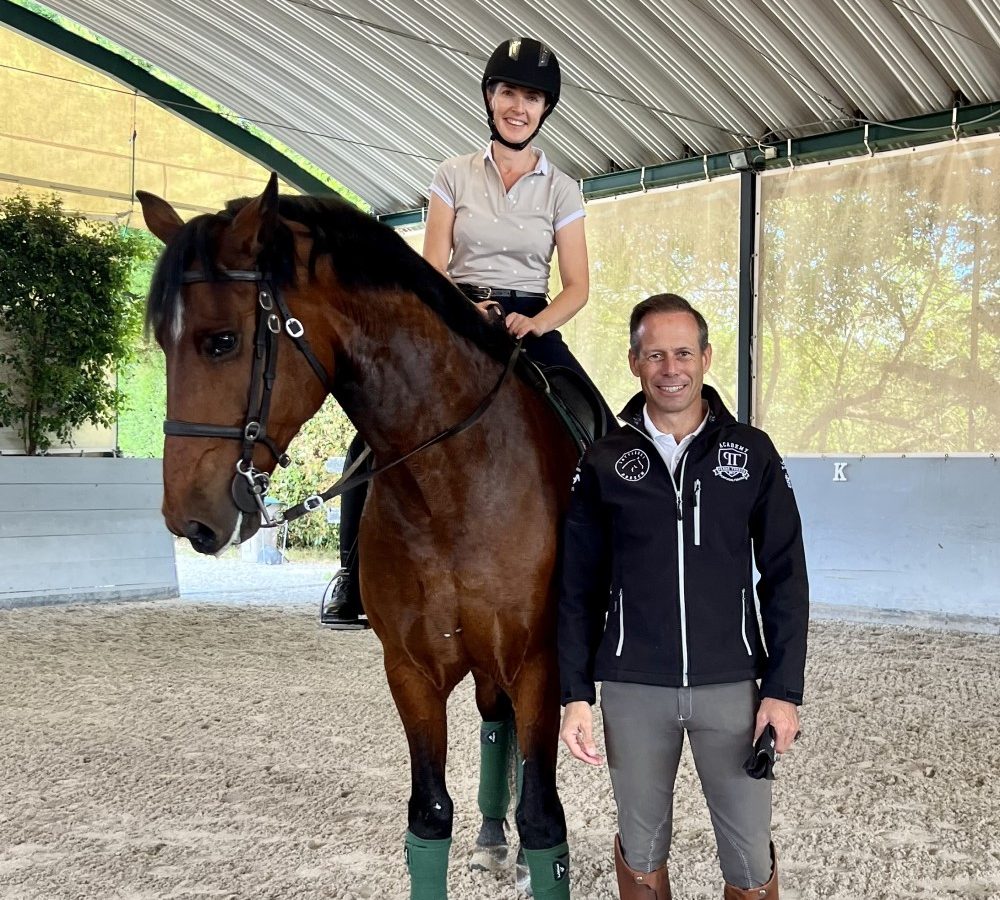
THE LEGENDARY PEDRO TORRES
My first lesson was with Pedro Torres, two-time World Champion of Working Equitation, Grand Prix dressage rider and highly sought-after clinician the world over. I found myself quite nervous as I prepared to ride; in recent years I have mainly ridden either my very-green-young-horses or my barely-serviceably-sound-semi-retired-eventer. I have not had regular instruction or competed for years, I felt very out of practise, and a wave of imposter syndrome flooded over me as I mounted. What right did this washed-up former eventer have to swing a leg over a Grand Prix horse for an hour of instruction with the legendary Pedro Torres?
“Pedro prepares the horse
you will ride in a way that is as
much a dance as it is a dressage warm-up.”
My nerves soon dissipated. Everything about being at Pedro Torres’ stables is relaxing. The horses, though mainly stallions living in stables, are calm and happy. Pep, the stable manager has the espresso machine pumping out shots when our group arrives, while groom Valentina calmly saddles horses with tender care and attention to every detail. Once in the arena, the sound of classical music fills the air, and Pedro prepares the horse you will ride in a way that is as much a dance as it is a dressage warm-up, complete with casual one-time flying changes down the centreline before he dismounts and lets you know it’s your turn.
Pedro is always smiling, always energetic, yet calm. “Relax!” he says to me as he observes my first steps, picking up immediately on my needless nerves. My mount, Irudito, is a charming Grand Prix-trained 10-year-old Lusitano gelding by the popular stallion Rubi AR, who like Pedro, immediately makes me feel like perhaps I can ride a bit and have every right to be there.
What a lesson! Pedro focused on my position and aids, making difficult things sound and feel straightforward as we progressed from 20m circles to lateral work, before moving on to flying changes including two-time tempis, then finishing with some piaffe and passage. It is an undeniable thrill to experience the high-level movements – yet as with all of the lessons I experienced on this tour – there were so many take-aways that I could directly apply to my riding back at home. Pedro encouraged me to apply aids with confidence and a bit more gusto than I typically use, and worked so much on my position, particularly during the transitions where I tend to collapse forward a little.
“Riding is just codes!” Pedro explains. “You learn the code, you teach the horse the code, and then you have to use the codes so he knows what you want!” During the course of the next week, we had the opportunity to watch Pedro ride several horses, and seeing this clarity of communication in practice was delightful. The horses never seemed to be confused, flustered or uncomfortable; Pedro’s aids were so consistent, clear and well-timed that the eye was drawn to the resulting picture of harmony and expression; we were watching a dance.
LOTUS THE STALLION
My next lessons were with Rita Ralao on a seven-year-old Lusitano stallion named Lotus. Rita is a Grand Prix dressage rider and member of the Portuguese Olympic Squad, and works alongside her Olympian father Miguel Ralao and mother Beatriz Ralao, who was our chief chaperone throughout the tour. Lotus looked like something out of a fairytale and was such a generous horse to ride. Lotus had not yet competed but was already schooling many advanced level movements. “There’s no rush,” Rita explains, “I want to wait till he can bring all the movements together, maybe we’ll do a small schooling show soon.” This was so refreshing to hear, and I struggled to imagine a comparable scenario in Australia whereby a young stallion with this much quality and training – who was nevertheless still green and learning his job – would be available to an amateur and complete stranger such as myself for lessons. As a group of riders, all of us on the tour were so humbled by the generosity of our coaches and the opportunity to ride their personal horses.

Like most horses, Lotus was stiffer on one side than the other and I took away so much from Rita about how to work both with and through this, which has since been invaluable with my young horses at home. Much of the focus was on straightness and rather than hyper-focusing on the stiffness to one side, equal emphasis was placed on correctness on the “easier” side. As we progressed through comprehensive warm-ups to walk pirouettes, half-pass, and flying changes, the stiffness was less noticeable and Rita was quick to point out the lack of discipline in my riding style, in the nicest possible way.
“Collect the walk! It looks like you’re going for a walk in the forest, not like you’re about to do a transition,” Rita observes. It’s hard not to laugh at yourself at these moments; years of plodding around on my own have clearly led to a fairly casual riding style.
“I should be able to look at you and know exactly where you’re going and what you’re doing, but right now I don’t know whether you’re doing collected trot or working trot, or whether you’re on a 20m circle or on the short side!” Rita continues. These gentle reminders about the importance of accuracy and clarity, even when you’re not in a competition mindset, were a wake-up call I needed. How can my young horses progress, build strength and discipline, and become performance horses if I am not clear and consistent every time I ride them? How do they know what I want if it’s not even clear to an educated eye on the ground? Classical riding is not casual riding, as my aching muscles reminded me at the end of my two-lesson days on tour; it’s hard yet rewarding work.
As the tour progressed, so did my confidence; I could feel my “riding legs” starting to return. On Day 4, I experienced a day so special that the memories will never leave me. An amazing second lesson with Pedro Torres in the morning felt hard to top; I was finding my groove with Irudito, and at the end of the lesson I managed nine one-time flying changes in a row.
“Really good! Really, really good!” Pedro is calling out, while my cheer squad – the rest of the tour group – whoop, holler and clap me on from the corner of the arena, where they sit sipping espresso coffee and filming me. What a thrill! Heading to Portugal, I knew I would have the chance to experience piaffe and passage just like I did during my 2017 trip – piaffe/passage seems so effortless for the Lusitanos – however, one-time flying changes were not something I thought I’d ever experience in my life.
LUSITANO STUD VISIT
After that lesson, with me floating around on Cloud Nine, our group headed north of Lisbon to Joao Pedro Rodrigues’ beautiful stud farm. We had already met Joao Pedro briefly earlier in the week when we visited the Portuguese School of Equestrian Art, an incredible experience made more special by a behind-the-scenes tour with one of the riders, Carlos Tomas. Joao Pedro Rodrigues joined the Portuguese School of Equestrian Art in 1980, one year after it was founded, then went on to complete an internship at the Spanish Riding School in 1983, and has been Master-Chief Rider of the Portuguese School of Equestrian Art since 2012.
It was an honour to visit Joao Pedro’s home and stud farm, Coudelaria Joao Pedro Rodrigues, a beautiful property that is the birthplace of many of Portugal’s most successful Lusitano horses. A kind and thoughtful man, Joao Pedro managed to perfectly match each of us with our lesson horses.
“Perhaps you can ride my old stallion,” Joao Pedro said to me with a smile and a nod, after hearing a little about our riding level. The last of the group to ride, I didn’t think much about who this old horse might be as I lounged about in the spring sunshine watching my friends’ lessons. It was not until I headed to the stables to mount up that my excitement started to peak.
“You are riding Rouxinol?” Joao Pedro’s staff asked. I saw a handsome grey stallion waiting saddled. “Is he the old stallion?” I asked, reaching out to pat him, tentatively adding, “Is he a nice one?”
“He is a really, really nice one!” came the earnest reply, and I started to learn more. Rouxinol is 25 years old, bred by Joao Pedro, and a legendary breeding stallion. A full brother to Oxidado, the stallion with which Pedro Torres dominated the sport of Working Equitation for many years, Rouxinol himself has also competed in Working Equitation and trained to Grand Prix dressage, while his immense success as a breeding stallion has been the focus of his career.

I could not believe the horse that stood before me was 25 years old. He looked incredible, and as I soon found out, he felt as good as he looked. He didn’t walk to the arena, he strutted; even if I had not been told that I was riding a very special horse, I would have quickly worked it out from the feeling he gave me, even walking along on a loose rein. This horse embodied the beauty, purity and purpose of Classical Dressage training; despite his grand age, Rouxinol was sound, happy, supple, straight, even, responsive and expressive, a true delight.
Sometimes I look back at amazing experiences I’ve had in the saddle and wish I’d realised at the time just how special they were. This was different – from the moment my foot reached for the stirrup I was acutely aware that I was experiencing a ride that would stay with me forever and I was determined to soak up every second of it.
Joao Pedro took us through a methodical warm-up, with plenty of transitions and basic lateral work, while I revelled in the feeling this exceptionally light, sensitive, and powerful horse gave me. Joao Pedro’s timing as an instructor was brilliant; he communicated everything so calmly and clearly at just the right moments, and I found my riding step up a level as the experience unfolded. We progressed through some wonderful exercises focused on straightness and correctness, ensuring Rouxinol was well warmed up for the more advanced movements, and that my aids and position were correct.
Then came piaffe and passage, extended trot, and flying changes. Rouxinol was so responsive and energetic, yet never anticipated; this generous stallion gave the most incredible feeling of “try” and harmony. It was an emotional moment for me to finish the lesson with one-time changes on this legendary horse, under the guidance of the legendary Joao Pedro Rodrigues. I didn’t want the ride to end, or the day for that matter. I knew I would have an amazing time in Portugal, but I never expected to ride one-time changes, piaffe and passage twice in a day on two different horses with two of the great Portuguese masters of this era!
HOSPITALITY & GENEROSITY
With Rouxinol hosed off and returned to his stable, Joao Pedro took us all out to see his broodmares, foals and young horses, before inviting us into his home for some evening refreshments. His hospitality and generosity were so touching, and his insights into the Lusitano breed were fascinating. Truly passionate about the Lusitano horse, Joao Pedro talked much about the breed’s history and development as bullfighting horses, which is a key reason for their sensitivity and physicality. Night was falling, and this magical day had to end – it was about 9:30pm when we landed back at our hotel, and I certainly slept well that night.
While dressage was the focus of our lessons, we also had the opportunity to visit the stables of Gilberto Filipe, World Champion of Working Equitation in 2018 and 2022, for a lesson. Riding in groups of three, we started in Gilberto’s beautiful indoor arena before heading outside to try our hand at the obstacles. It was lots of fun, and certainly gave us an appreciation for the co-ordination, quick thinking and agility this sport requires of both horse and rider.
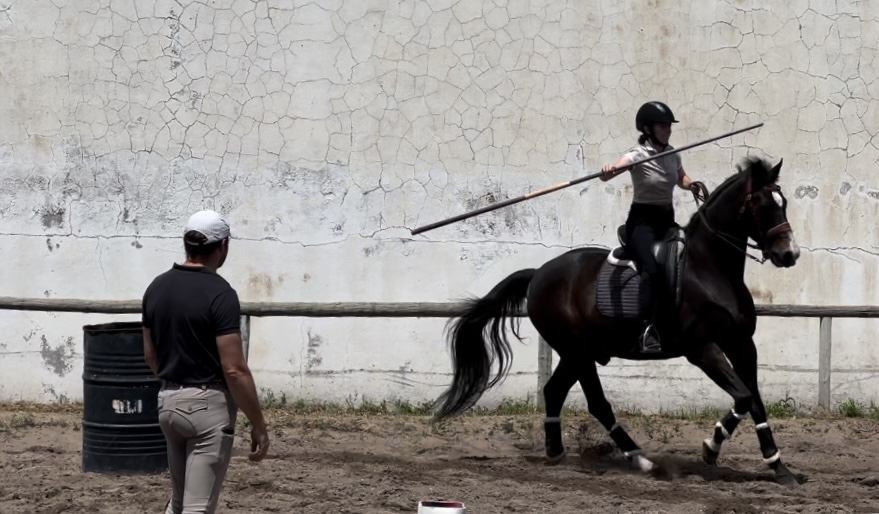
“I didn’t want this trip to end…”
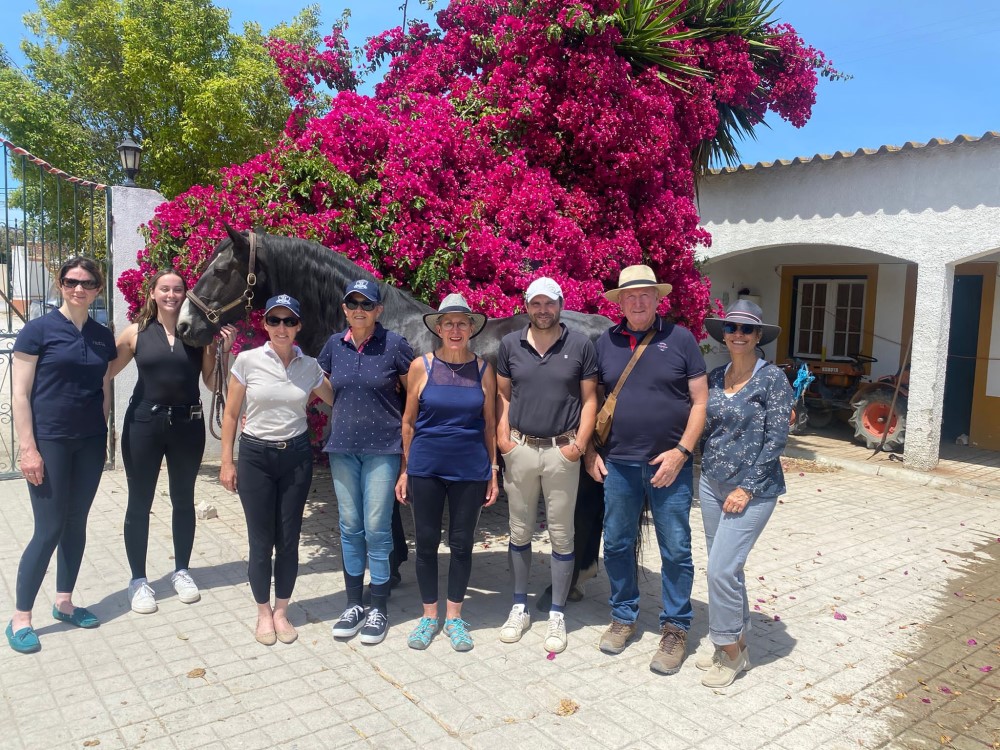
Our ridden experiences also included a beach ride at Comporta, Europe’s longest beach, and preferred riding spot of none other than Madonna! As we rode along, our host casually gestured towards the horse Ruth was riding and said, “That horse belongs to Madonna. She has two that she keeps here, she comes and rides them a few times a year.” While this has not been fact-checked, we had no reason to doubt the validity of the story!
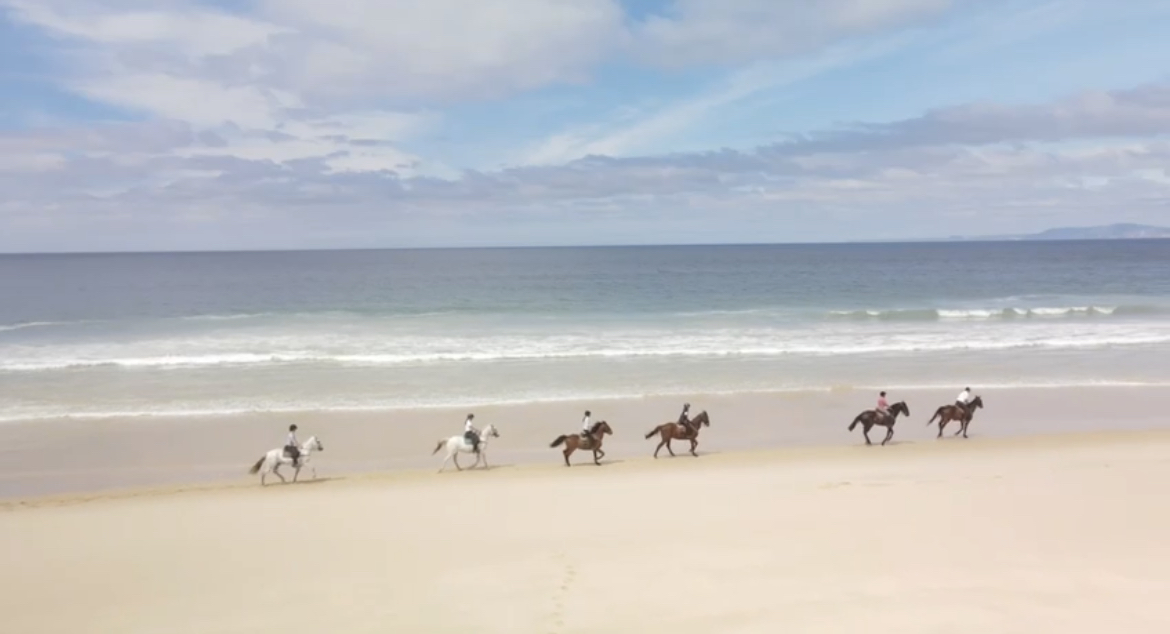
I didn’t want this trip to end, however Day 10 rolled around and my flight home beckoned. My final day in Portugal was as jampacked as all those before it; by this point, most of my fellow tourgoers’ Portuguese adventures had already finished and only Scottish Heather and I remained. After watching Heather have a lesson with Pedro Torres, Beatriz Ralao took us to Quinta dos Cedros to view some young horses for sale, then a delicious lunch at Restaurante Tia Alice, before taking us to Quinta da Fonte Santa for my final lesson before departing for the airport.
My lesson was with Francisco Bessa de Carvalho, “Quico” to his friends. A rider at the Portuguese School of Equestrian Art since 1984, he is now the Vice-Chief rider, and is also the founder of the renowned stud farm, Lusitanos d’Atela. Like all the wonderful instructors we met in Portugal, Quico was so generous and thorough in his lessons. I rode Fado, a schoolmaster who knew all the moves yet made me focus on my position and aids; anything less than accurate correct riding would simply not produce the goods! Riding in the most beautiful indoor arena I’ve ever seen, we spent an hour focusing primarily on my position and accuracy, and the last 20 minutes or so of the lesson we worked on the transitions between piaffe, passage and collected trot. It was an excellent lesson, leaving me with plenty to contemplate and reflect upon during the 24-hour trip home that lay ahead of me.
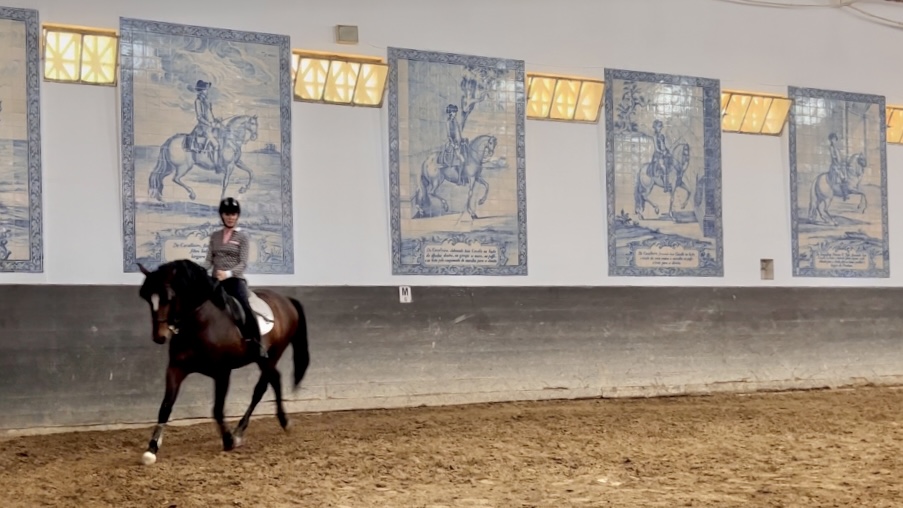
A dressage bootcamp on the other side of the world is not a substitute for ongoing, regular instruction on your own horses, and you don’t morph into a dramatically better rider in just 10 days, however, this trip was the stuff dreams are made of and has had a profound, lasting impact on my riding. From the generosity of the people – and horses – that we met, to the experiences and skills we gained, it exceeded every expectation I harboured, and I now ask myself not whether I will return to Portugal – but when! EQ
YOU MIGHT ALSO LIKE TO READ:
Africa is Calling You – Equestrian Life, January/February 2024

